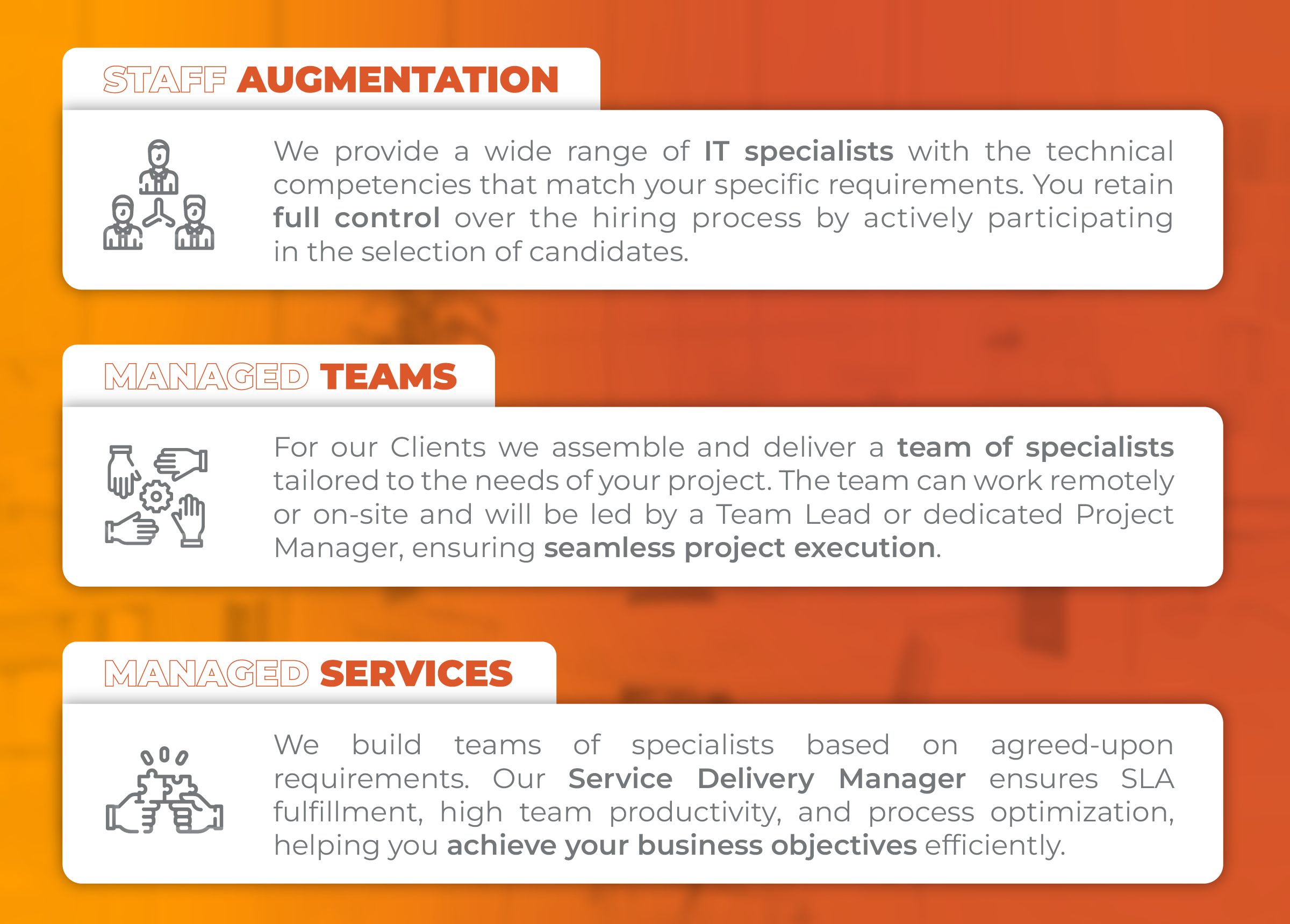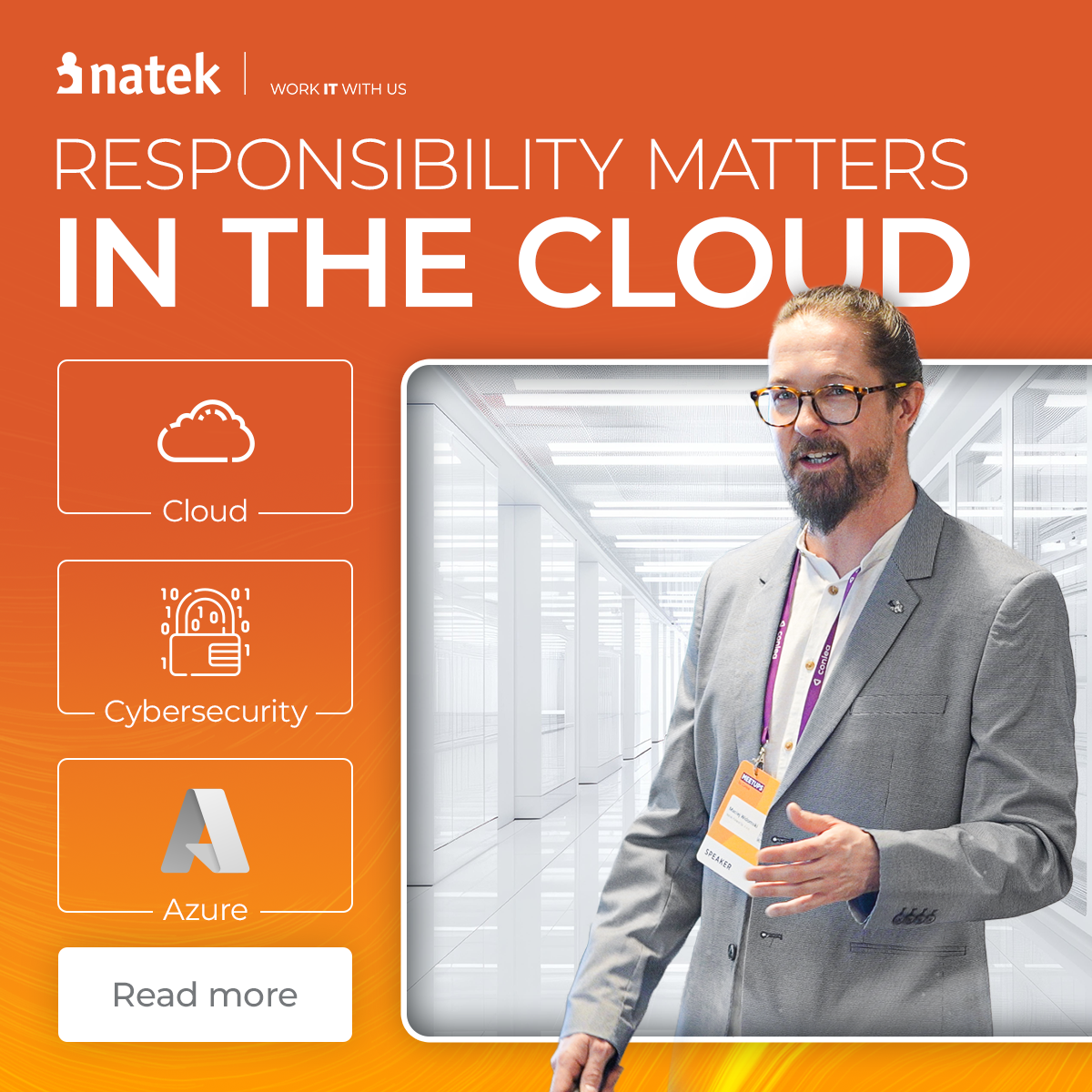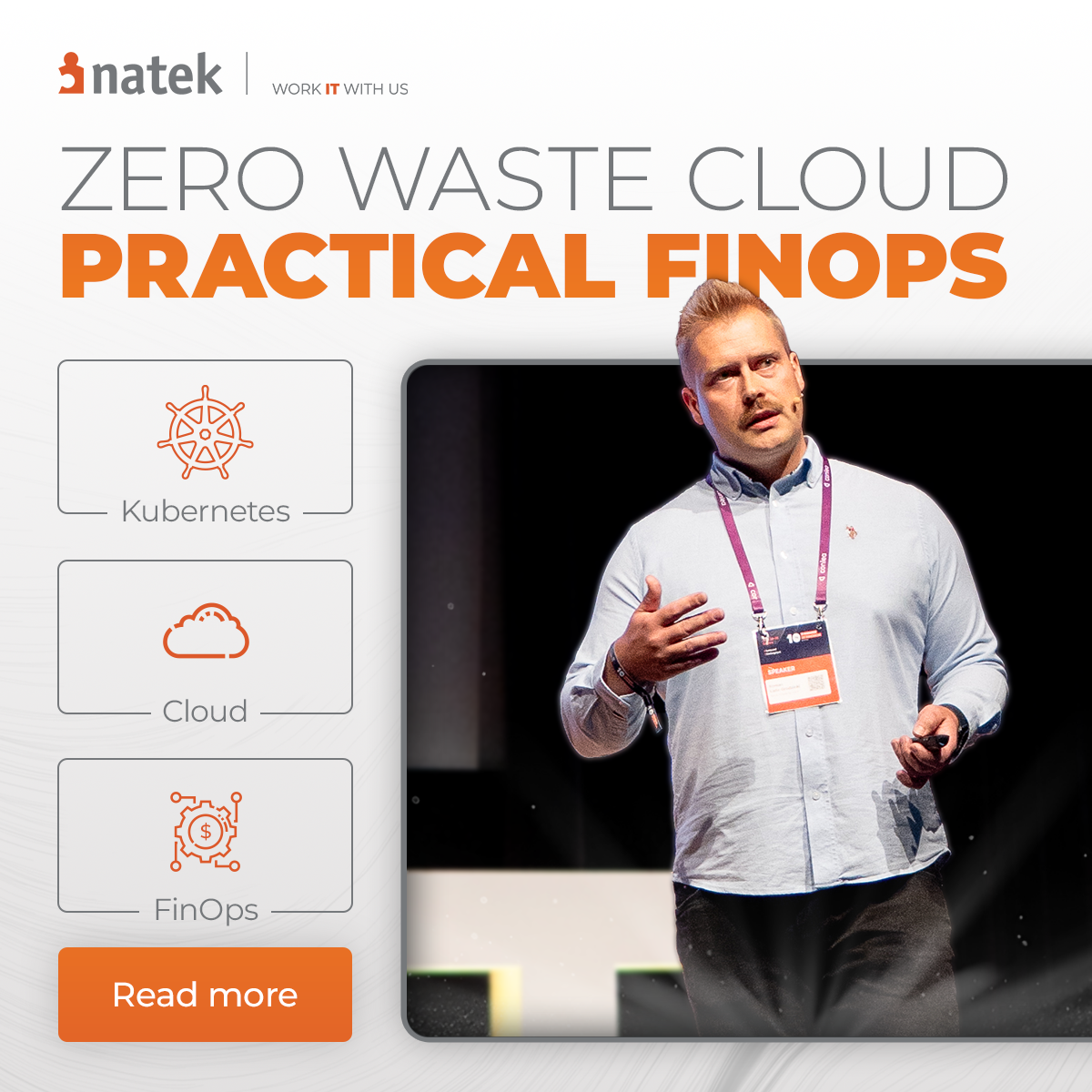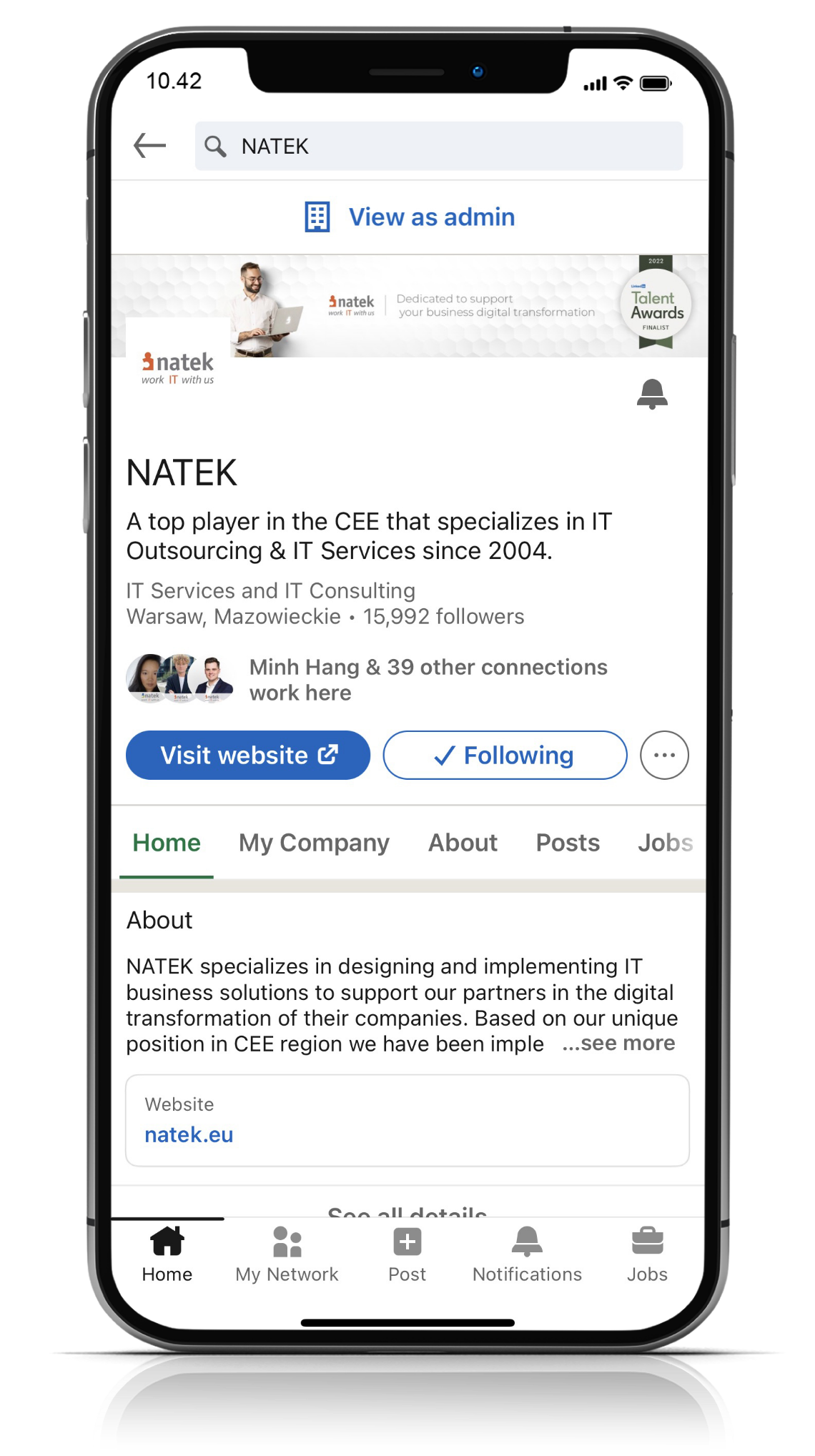Whether you’re building a product from scratch, expanding your development team, or offloading entire IT functions, choosing the right outsourcing model is critical to success. Large corporations often outsource IT and customer service functions to other countries to enhance profitability and competitiveness. But with terms like Staff Augmentation, Managed Team, and Managed Services often used interchangeably or misunderstood - how do you know which one truly aligns with your goals?
In this article, we’ll break down each outsourcing model and help you determine which approach fits your organization’s needs best. Whether you’re a startup aiming for agility or an enterprise optimizing for long-term efficiency, understanding these models will help you make smarter, more strategic decisions.
Staff Augmentation: speed and flexibility with full client control
Staff augmentation is a highly flexible engagement model designed for companies that need to quickly scale their teams without going through lengthy internal hiring processes. In this setup, the client retains full control over project delivery, while the service provider - like NATEK - supplies skilled professionals tailored to the client’s needs. In contrast, in-house teams are necessary when an organization requires maximum control, confidentiality, or compliance with internal policies and legal requirements, whereas staff augmentation services provide flexibility and rapid access to external talent.
Staff augmentation in 5 simple steps:
- Once the client’s Hiring Manager defines the requirements, NATEK Experts organize a kickoff meeting and assign a team of Recruiters and Researchers to find suitable Candidates.
- Our Recruiters conduct full interviews with each Candidate to assess both technical skills and cultural fit.
- Once a candidate is selected, their profile is reviewed—either by our Sales team or Account Delivery Manager—before being submitted to the client for approval.
- The final say belongs to the client, who selects candidates for customer interviews and can suggest changes to the requirements based on initial feedback.
- If a candidate does not perform according to expectations, we provide a replacement to ensure minimal disruption.
Staff augmentation is especially useful in situations where time matters. For example, a bank may have a budget for a new project and needs new hires. At NATEK, we set a target of 3 days to present the first suitable candidate. Thanks to the specialization of our Recruitment Team, we have the tools, experience, and market knowledge to bring the best available candidates and deliver fast, long-lasting enhancements to your business.
Continuous support from NATEK Account Delivery Managers
While the responsibility for project outcomes lies with the client’s internal manager, we don’t just hand off a CV and walk away. An Account Delivery Manager (ADM) oversees the process, ensuring smooth communication, onboarding support, and ongoing engagement. ADM acts as the main point of contact throughout the partnership. If the candidate or client is dissatisfied, we step in to mediate and find a solution. Whether it’s a request for a raise or additional training, we handle it - ensuring the relationship stays productive and professional for both sides.
“Transparency is key. What’s important is to provide honest insights into each candidate’s background. We focus not only on technical fit, but we spend a lot of time to check cultural alignment with the client’s team.”
Paulina Grzywacz, NATEK Head of Account Delivery Management
Staff Augmentation in practice: supporting a grocery retail chain with SAP specialists
A great example of staff augmentation in action comes from a network of small grocery stores that needed to strengthen its internal SAP team. The client faced a talent gap across several key areas, including SAP authorizations, security, and core modules like Finance and Controlling. Instead of going through a lengthy hiring process, they turned to us to quickly fill those gaps with experienced consultants. Small businesses can use staff augmentation services to manage business expenses and improve work-life balance, making it easier to adapt to changing needs without the overhead of permanent hires.
We provided dedicated SAP specialists, fully integrated into the client’s team but employed by us. These experts worked side-by-side with internal staff, adapting to the client’s processes and tools. The flexibility of this model allowed the client to operate within different internal and external budget sources, allocating resources efficiently based on project priorities.
“Thanks to our broad market reach and specialized recruitment, we were able to supply qualified professionals in a matter of days - something that would have taken the client months to achieve internally. This solution not only accelerated their ongoing SAP initiatives but also gave them the ability to adapt resources as needed.”
Michał Lorek, NATEK SAP Solution Architect
Managed Team: shared responsibility with operational oversight
The Managed Team model is ideal for companies that want to extend their capabilities with a ready-to-go team - without managing every detail themselves. This approach strikes a balance between full outsourcing and internal control. It’s particularly effective for complex projects that require niche expertise and coordination, such as a SAP module rollout across multiple countries.
In this model, we assemble a dedicated team of specialists, typically including a Team Lead on our side, who not only participates in the work but also oversees day-to-day operations and serves as the primary technical and organizational lead. For example, for SAP projects, the team is carefully tailored to match both the technical requirements (e.g., SAP expertise) and local business context (such as tax laws and regulatory compliance in specific countries).
Clients can stay involved by selecting team members themselves, or they can delegate that responsibility to us - we’ll source professionals who meet the required qualifications. If something doesn’t work out, replacements are part of the agreement. Unlike pure staff augmentation, here there’s usually a contractual obligation to provide a temporary replacement, for example, during a team member’s two-week absence.
Co-sourcing is another approach that combines internal staff with external service providers to reduce risk and increase transparency, allowing organizations to maintain control over critical business processes while benefiting from specialized expertise.
Ultimately, the Managed Team model gives you a cohesive unit that operates semi-independently, guided by our leadership and in close collaboration with your business goals. It’s perfect when you want specialized talent, consistent delivery, and less micromanagement while still maintaining control and strategic direction over projects.
An additional advantage of both the Staff Augmentation and Managed Team models is the flexibility in offboarding. Typically, these models operate with a short notice period, allowing clients to scale down quickly if, for example, project funding ends or priorities shift.
In contrast, employing full-time internal staff often comes with longer termination procedures, severance packages, and legal obligations. With resources provided externally, clients can reduce financial and administrative risks, making these models especially attractive in uncertain or fast-changing business environments.
Another important benefit of the Staff Augmentation and Managed Team models is what happens after a project ends. When an assignment is completed or phased out, we don’t just let the talent go - we actively look for new projects where their skills and experience can be a good match.
This not only helps consultants stay engaged and grow professionally but also allows us to retain proven talent and quickly mobilize them for future opportunities - often with reduced onboarding time. It’s a win-win for both the specialists and the clients who benefit from their continued availability and expertise.
Managed Services: SLA-Driven support with outcome ownership
The Managed Services model is built around clearly defined outcomes, shared resources, and service level agreements (SLAs). In the Managed Services model, shared resources means that the same team of consultants can support multiple clients or services, rather than being fully dedicated to one project. This approach increases efficiency and cost-effectiveness, allowing clients to access specialized skills when needed - without paying for full-time availability. It’s the right choice for organizations that want to outsource a specific function or process completely, with a strong focus on performance, continuity, and measurable results - such as IT support, infrastructure maintenance, or application monitoring.
Managed Service Providers (MSPs) offer a defined set of services, including remote monitoring, remote firewall administration, and remote support, to manage end user systems and infrastructure management for their customers. MSPs help prevent service interruptions and manage tasks for customers such as government agencies, small businesses, and large corporations, ensuring business continuity and operational efficiency. Application service providers were pioneers in remote application hosting, paving the way for cloud computing and modern MSP business models that enable flexible, scalable service delivery. MSPs must comply with legal requirements and protect the company's confidential data when they perform services for clients, ensuring regulatory compliance and data security.
Unlike in staff augmentation or managed team setups, there’s no dedicated Account Delivery Manager (ADM) here. Instead, the process is overseen by a Service Delivery Manager (SDM) - a technically competent leader who understands the service scope, knows the contract inside out, and ensures all key performance indicators (KPIs) are being met.
KPIs are central to this model and may include metrics like:
- Response time
- Resolution time
- Reaction time
These metrics are formalized in a Service Level Agreement (SLA). For instance, an issue reported via the client’s ITSM (ticketing system) must be responded to within a set timeframe. While we aim to meet resolution time targets, external dependencies (like Microsoft services) can sometimes affect our ability to close tickets within expected windows - something we account for in SLA negotiations.
Common Delivery Models:
- Standard Business Hours: e.g., Monday to Friday, 7 AM – 5 PM
- Follow-the-Sun 24/7: uninterrupted global support, regardless of time zones or staff availability
- Scheduled Maintenance: e.g., 2- 3 days every two months, focused on proactive system checks, maintenance and backup operations.
Case in point: A game development company outsources Level 1 support. Since their internal tools for Levels 2 and 3 require niche expertise, we focus on providing knowledgeable, English-speaking L1 consultants who can handle routine troubleshooting and escalate when needed. With global offices outside the European Union, their operations demand 24/7 availability, which we deliver through a resilient, shared-services model that ensures continuity - no matter what.
“Managed Services is about trusting your partner to deliver results, not just hours. If uptime, responsiveness, and accountability are what you need most, this model offers reliability, predictability, and peace of mind.”
Dominika Krawczak, NATEK Business Development Manager
Choosing the right model for your business
Whether you’re looking to quickly scale your team, delegate part of a project, or fully outsource a business function, understanding the differences between Staff Augmentation, Managed Team, and Managed Services is key to making the right decision.
Risk management, responsibilities, and clearly defined tasks are critical when outsourcing or managing projects with an external provider to ensure accountability and minimize potential issues. Examples of staff augmentation services include supporting an in house team with specialized talent or outsourcing a single point of failure to a managed service provider for greater reliability. Government agencies hire MSPs to manage IT infrastructure and support business processes, ensuring compliance and continuity in public sector operations. The benefits of outsourcing include improved efficiency, and access to advanced technologies and expertise that drive business growth. Moving forward, organizations should evaluate their business models and manage their resources to stay competitive in a rapidly changing industry.

- Staff Augmentation offers speed and flexibility, ideal when you want to stay in control but need specific skills - fast.
- Managed Team gives you a dedicated, coordinated group of experts led by a team lead, perfect for project-based work where you share responsibility but still stay close to the action.
- Managed Services is the hands-off approach, where performance is measured by results, not effort - ideal for ongoing, SLA-driven operations like IT support or system maintenance.
There’s no one-size-fits-all answer. The best model depends on your goals, internal capabilities, urgency, and budget. In many cases, a combination of these models can work together to provide the agility and efficiency your business needs.
Still unsure which model fits your situation best? We’re here to help you evaluate your needs and craft a solution that makes sense - both technically and strategically. Tell us what you need by sending a message to NATEK Sales Prospection Team Lead Andrzej Osman at andrzej.osman@natek.eu or go fill out our Contact form to begin our cooperation and #growITwithus!



